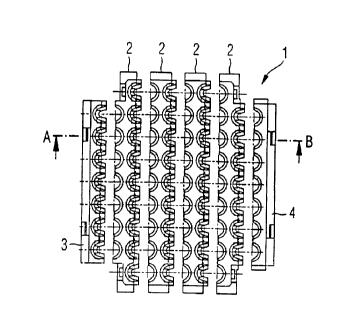Some of the information on this Web page has been provided by external sources. The Government of Canada is not responsible for the accuracy, reliability or currency of the information supplied by external sources. Users wishing to rely upon this information should consult directly with the source of the information. Content provided by external sources is not subject to official languages, privacy and accessibility requirements.
Any discrepancies in the text and image of the Claims and Abstract are due to differing posting times. Text of the Claims and Abstract are posted:
| (12) Patent: | (11) CA 2232566 |
|---|---|
| (54) English Title: | METHOD FOR MAKING CONTACT WITH A MULTIPOLE FEMALE STRIP CONNECTOR |
| (54) French Title: | PROCEDE DE MISE EN CONTACT D'UN CONNECTEUR A BANDE DE RACCORD FEMELLE |
| Status: | Deemed expired |
| (51) International Patent Classification (IPC): |
|
|---|---|
| (72) Inventors : |
|
| (73) Owners : |
|
| (71) Applicants : |
|
| (74) Agent: | FETHERSTONHAUGH & CO. |
| (74) Associate agent: | |
| (45) Issued: | 2002-08-20 |
| (86) PCT Filing Date: | 1996-09-10 |
| (87) Open to Public Inspection: | 1997-03-27 |
| Examination requested: | 1998-03-19 |
| Availability of licence: | N/A |
| (25) Language of filing: | English |
| Patent Cooperation Treaty (PCT): | Yes |
|---|---|
| (86) PCT Filing Number: | PCT/DE1996/001700 |
| (87) International Publication Number: | WO1997/011512 |
| (85) National Entry: | 1998-03-19 |
| (30) Application Priority Data: | ||||||
|---|---|---|---|---|---|---|
|
Method for making contact with a multipole female strip
connector
The present invention relates to a method for making
contact with a multipole female strip connector for plug
connections with coaxial connecting cables.
In order to simplify the method and to save
tools, a multi-row female strip connector is split into
plastic disks, one side of the disk having insulation-
piercing terminals which are arranged one behind the
other and are connected to contact springs, and the other
side having correspondingly formed, overmolded pressure
pieces. The disks are held spaced apart in a pressing
tool by means of corresponding press-in pins which have
a force fit. Coaxial connecting cables, which are cut to
length and at whose free ends the outer insulation and
the shield mesh have been removed over a predetermined
length, are pushed into these disks, which are
preassembled spaced apart. When the disks are pressed
together, the pressure pieces press the connecting wires
into the insulation-piercing terminal.
La présente invention concerne un procédé permettant de mettre en contact un connecteur multipolaire à ressort destiné à la réalisation de connections par fiches avec des câbles de raccordement coaxiaux. Pour que le procédé soit simplifié et que le nombre d'outils soit limité, un connecteur à ressort à plusieurs rangées est divisé en disques de plastique, un côté de chaque disque présentant des éléments autodénudants placés l'un derrière l'autre et reliés à des ressorts de contact, et l'autre côté présentant des éléments de pression moulés par injection de façon à avoir une forme correspondante. Les disques sont espacés par des broches correspondantes insérées à ajustage serré. Des câbles de connexion coaxiaux coupés à la longueur désirée sont insérés dans ces disques prémontés et espacés, une longueur prédéfinie de l'isolation extérieure et de la tresse de blindage ayant été enlevée aux extrémités libres desdits câbles. Lorsque les disques sont pressés les uns contre les autres, les fils de connexion sont pressés contre l'élément autodénudant par les éléments de pression.
Note: Claims are shown in the official language in which they were submitted.
Note: Descriptions are shown in the official language in which they were submitted.

For a clearer understanding of the status of the application/patent presented on this page, the site Disclaimer , as well as the definitions for Patent , Administrative Status , Maintenance Fee and Payment History should be consulted.
| Title | Date |
|---|---|
| Forecasted Issue Date | 2002-08-20 |
| (86) PCT Filing Date | 1996-09-10 |
| (87) PCT Publication Date | 1997-03-27 |
| (85) National Entry | 1998-03-19 |
| Examination Requested | 1998-03-19 |
| (45) Issued | 2002-08-20 |
| Deemed Expired | 2004-09-10 |
There is no abandonment history.
| Fee Type | Anniversary Year | Due Date | Amount Paid | Paid Date |
|---|---|---|---|---|
| Request for Examination | $400.00 | 1998-03-19 | ||
| Registration of a document - section 124 | $100.00 | 1998-03-19 | ||
| Application Fee | $300.00 | 1998-03-19 | ||
| Maintenance Fee - Application - New Act | 2 | 1998-09-10 | $100.00 | 1998-08-17 |
| Maintenance Fee - Application - New Act | 3 | 1999-09-10 | $100.00 | 1999-08-12 |
| Maintenance Fee - Application - New Act | 4 | 2000-09-11 | $100.00 | 2000-08-18 |
| Maintenance Fee - Application - New Act | 5 | 2001-09-10 | $150.00 | 2001-08-16 |
| Final Fee | $300.00 | 2002-06-06 | ||
| Maintenance Fee - Patent - New Act | 6 | 2002-09-10 | $150.00 | 2002-08-16 |
Note: Records showing the ownership history in alphabetical order.
| Current Owners on Record |
|---|
| SIEMENS AKTIENGESELLSCHAFT |
| Past Owners on Record |
|---|
| SEIBOLD, JURGEN |
| SEIDEL, PETER |
| ZELL, KARL |